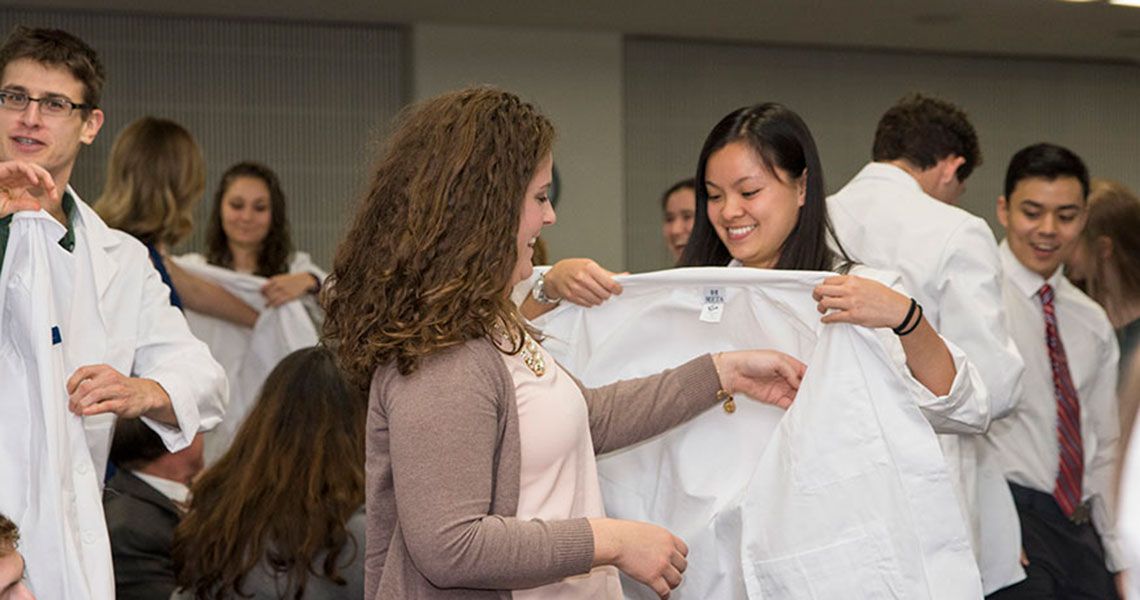Words of advice, praise, and encouragement were offered up at the GW School of Medicine and Health Sciences (SMHS) Physical Therapy (PT) Convocation to help first-year students reflect on the journey ahead.
For seven straight years, the PT program has had a 100 percent pass rate on the National Physical Therapy Examination, thanks to the dedication of those involved in the program, Joseph Bocchino, Ed.D. ’03, M.B.A., senior associate dean for health sciences and associate professor of clinical research and leadership at SMHS, said in his welcoming remarks at the event, held Oct. 25.
“Someone might say we’re lucky, but that’s not luck. It’s an incredibly dedicated faculty, it’s a careful selection process in terms of the students who come in here, and it’s a dedication through the entire process,” he said.
Joyce Maring, DPT, Ed.D., director of the Doctor of Physical Therapy Program and chair and associate professor in the Department of Physical Therapy and Health Care Sciences at SMHS, in her remarks, thanked Bocchino for all he has done for the PT program. Bocchino will step down from his administrative role as dean effective at the beginning of the new year, she said.
“I would be really remiss if I did not make you aware of how much his leadership has meant to the program and has fostered the success that we currently enjoy,” she said.
Current students, residents, and faculty also were recognized at the annual event for their passion and commitment.
That included members of the Physical Therapy Student Organization Classes of 2017 and 2018. “It is an honor to work with such amazing students who really have such dedication to their program here at GW and to their future profession,” said Erin Wentzell, DPT, assistant clinical professor of physical therapy and health care sciences.
Residents also were acknowledged for their hard work in achieving post-professional competencies, including three orthopedic residency students and two neurologic residency students. In addition, Wentzell spoke about the PT program’s first pediatric resident.
A new part of the convocation included the presentation of an award recognizing the role of mentorship in residency education. The inaugural GW Excellence in Residency Mentorship Award, which will be presented annually to honor an outstanding residency program mentor, went to Susan Ryerson, D.Sc., PT, research scientist at MedStar National Rehabilitation Hospital.
“[Ryerson] is a true resource for our residency program. She has been a tireless advocate and educator,” said Elizabeth Ruckert, DPT, director of the MedStar-GW Neurologic Residency program and assistant professor of physical therapy and health care sciences at SMHS.
Bringing the conversation back to the first-year students sitting in the audience, white coats covering their laps, keynote speaker William Boissonnault, D.H.Sc., DPT, Executive Vice President of Professional Affairs at the American Physical Therapy Association and Professor Emeritus at the University of Wisconsin-Madison, said the ceremony for them is another step to achieving a dream.
While that journey is not always an easy one, he said, students must let their educational and clinical instructors — and also their patients — guide them.
About 20 years ago, the Wisconsin Physical Therapy Association created a PT of the Year Award, Boissonnault explained. He was cynical about it at first, he said, imagining an Olympic-style competition with judges or PTs nominating themselves.
“But then I read beyond the title [and saw] the nominations came from patients or family members,” he said. “And on the first night of the award ceremony … patients were [there] along with the family members, which I wasn’t expecting.”
The letters of support written by those patients were read aloud at the ceremony. They blew Boissonnault away, and he started to collect copies after each ceremony. He now has 18 years’ worth of letters. They include stories of patients feeling listened to, respected, treated with dignity, supported, and encouraged. In one letter, he noted, the patient wrote of her PT: “She never gives up, so how can I?”
Focusing his gaze on the students in the audience, Boissonnault said the techniques they are learning are important, but are only one piece of the puzzle. “The patients will teach you and guide you if you let them. If you listen, observe, reflect, and practice,” he said.
He added that he hoped the white coat will serve as a reminder to students that every patient they work with could be writing letters about them. “Who knows, maybe someday I’ll be reading a letter about you in a ceremony like this,” he concluded.
The first-year students then stood, and with the help of second- and third-years, they donned their white coats. Tucked inside the pockets were letters of support and encouragement from GW alumni, letters those students may someday themselves write for those who will follow next.



